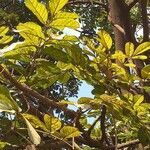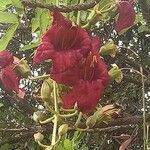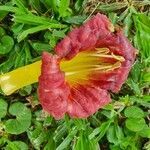It is a tree which loses many leaves during the year. It grows 9-18 m high. The crown is rounded. The trunk is short and straight and about 80 cm across. It often branches from the base. The branches spread out and the secondary branches hang down. The bark is dark grey and smooth but flakes off in patches. The leaves are compound leaves growing in threes. They occur at the ends of branches. They are light green. The leaves are divided into leaflets along the stalk with one leaflet at the end. There are 7-9 leaflets. They are smooth on the upper surface and can be downy underneath. The side leaflets do not have stalks. The end leaflet grows out as much as 30 cm from the last pair. The leaflets are rough and hard and up to 10 cm long. They can have a sharp tip. The edge of the leaflet is wavy. The flowers occur on long rope like stalks. These can be 2-3 m long. The flowers are trumpet like. The flowers are on long sprays which hang downwards. The flowers point out and upwards. The petals are bright red with yellow veins. The flowers are 6-8-15 cm long. They have an unpleasant smell. The fruit is like grey green "sausages". These are 30-60 cm long and 10 cm across. The stalk remains hanging on the tree. The seeds are inside the pulp.
Leaves opposite or in whorls of 3, imparipinnate, crowded towards the tops of the branches; leaflets (1) 2–5-jugate, sessile or subsessile, except the terminal ones with petiolule (0.7)1–4(6.5) cm., long; leaflet lamina 3.5–17.5 (22.5) x 2.5–11 cm., ovate elliptic, obovate to rounded, apex obtuse, broadly tapering to rounded or retuse ana not so often apiculate, base rounded to cuneate, slightly to profoundly asymmetric except in the terminal leaflet which is asymmetric, glabrous to more or less hairy in both surfaces sometimes more roughly hairy in the superior one, papyraceous to coriaceous, margins entire, serrate or toothed and sometimes conspicously wavy; lateral nerves (4)6–13 pairs impressed above, prominent below, venation laxly reticulate; petiole (2)3.5–14(16) cm. long; rhachis 3–25 (29) cm. long, sulcate above, terete below.
Widely branched tree, to 20 m. Leaves decussate or in whorls of 3-4, up to 50 cm; leaflets oblong, entire or serrate distally, glabrous or hairy on nerves, to 20 by 6 cm. Flowers nocturnal, coarse, in terminal, pendent, narrow panicles up to 2 m long; calyx greenish, 2-3 cm, 2-lipped; corolla outside yellowish, veined, inside dark wine-red, 5-10cm; basal tube as long as the calyx or longer. Berry sausage-like, 25-50 by 7½-15cm, often on still flowering panicles.
Corolla large, 6–12 cm. long, widely cup-shaped, at first yellowish, later becoming reddish to purplish, streaked darker inside and outside, glabrous except sometimes at the point where the filaments become free; limb bilabiate, the superior lip bilobed, the lower one 3-lobed and recurved, lobes more or less rounded; corolla tube cylindrical at the base and suddenly widening and incurving upwards.
Tree, up to 25 m high. Leaves opposite or in whorls of 3, imparipinnate, crowded towards ends of branches. Flowers in pendulous, lax, terminal panicles. Fruit sausage-shaped, indehiscent. Flowers yellowish at first, becoming reddish to purplish, streaked darker inside and outside.
Calyx shortly tubular to campanulate, (1.7)2–4.3 cm. long, irregularly 4–5 lobed with the lobes up to 1 cm. long, ribbed, glabrous to sparsely puberlous outside, sometimes with irregularly scattered small glands.
Flowers in pendulous very lax, terminal panicles, 30–100 (150) cm. long, longly pedunculate; pedicels 1–11 (13.5) cm. long, upcurved at the tip; bracts small lanceolate caducous.
Fruit sausage-shaped up to 1 m. long and 18 cm. in diam., pendulous from a long peduncle, greyish-brown, lenticellate in the youth, massive, wood-walled, indehiscent.
Stamen-filament 3.5–6.5 cm. long, adnate up to 1–2.5 cm. from the base of the corolla tube; anthers 7–13 mm. long; staminode rather large.
Flowers variable in colour, purplish-red, purple-yellow, orange, greenish-yellow, and sometimes spotted with darker reddish colours
Seeds 10 x 7 mm. numerous, wingless, embedded in a fibrous pulp; testa coriaceous; cotyledons folded.
Disk c. 1 cm. in diam. 2–3 mm. high, fleshy, irregularly lobed, sometimes almost truncate.
Ovary 8–15 mm. long, cylindrical; style 4–7(8) cm. long, filiform.
Medium or large sized tree up to 25 m. tall.
A medium-sized tree 20-50 ft. high
Fruits like long sausages












